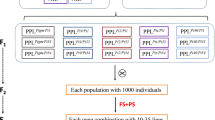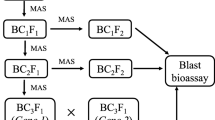Abstract
Rice blast is one of the most destructive diseases of rice. The most effective way of managing this disease is to develop resistant cultivars by introducing resistance genes into elite rice recipients. In this study, the near-isogenic lines (NILs) of six resistance alleles of the Piz locus (Pizt, Pi2, Pigm, Pi40, Pi9 and Piz) were constructed with Yangdao 6 as genetic background. Seedling inoculation tests showed that most of the NILs, namely NIL-Pi2, NIL-Pigm, NIL-Pi9, NIL-Pizt and NIL-Pi40, exhibited good resistance to blast with resistance frequencies (RFs) of over 82.50 %, execpt NIL-Piz which showed lower resistance with a RF of only 36.13 %. Furthermore, the improved-resistance NILs exhibited high similarity of their resistance spectra, with overlapping degrees of resistance spectrum (OD) of more than 75.83 %. However, the RF of panicle blast for all NILs decreased significantly compared with seedling blast in an artificial inoculation test. Although NIL-Pigm showed a higher panicle blast RF of 80 %, other NILs with outstanding performance in seedling blast resistance, namely NIL-Pizt, NIL-Pi2, NIL-Pi9 and NIL-Pi40, exhibited middle or low RFs of panicle blast with values from 56.67 to 33.30 %. Natural induction in a disease nursery showed a consistent trend in artificial inoculation results at seedling and heading stages. While NIL-Pigm was found to exhibit good resistance to leaf blast and panicle blast, NIL-Pi9 and NIL-Pizt were further demonstrated to show excellent resistance in Suichuan, Jiangxi province and Enshi, Hubei province, respectively, because of the race–region specificity. Agronomic traits of NILs were also investigated in order to evaluate the linkage drag effect of different alleles of the Piz locus. The resistance effects of the different alleles of the Piz locus under identical genetic background against seedling blast and panicle blast was first reported in this study, and the above results are expected to provide a theoretical support for the rational utilization of broad-spectrum resistance genes in breeding practice.




Similar content being viewed by others
References
Chen D, Zeigler R, Ahn S, Nelson R (1996) Phenotypic characterization of the rice blast resistance gene Pi-2(t). Plant Dis 80:52–56
Chen FR, Ruan HC, Yang XJ, Lin SC, Fang Q, Yan Y (2006) The correlation in seeding blast, leaf blasts and neck blasts of rice. Chin Agric Sci Bull 22(7):440–443
Dai ZY, Zhao BH, Liu XJ, Xia GH, Tan CL, Zhang BQ, Zhang HX (1997) A new middle-mature indica rice variety Yangdao 6 with high yielding, high quality and multiple disease resistance. Jiangsu Agric Sci 4:13–14
Dean RA, Talbot NJ, Ebbole DJ, Farman ML, Mitchell TK, Orbach MJ, Thon M, Kulkarni R, Xu JR, Pan H, Read ND, Lee YH, Carbone I, Brown D, Oh YY, Donofrio N, Jeong JS, Soanes DM, Djonovic S, Kolomiets E, Rehmeyer C, Li W, Harding M, Kim S, Lebrun MH, Bohnert H, Coughlan S, Butler J, Calvo S, Ma LJ, Nicol R, Purcell S, Nusbaum C, Galagan JE, Birren BW (2005) The genome sequence of the rice blast fungus Magnaporthe grisea. Nature 434:980–986
Deng Y, Zhu X, Shen Y, He Z (2006) Genetic characterization and fine mapping of the blast resistance locus Pigm(t) tightly linked to Pi2 and Pi9 in a broad-spectrum resistant Chinese variety. Theor Appl Genet 113:705–713
Deng Y, Zhu X, Xu J, Chen H, He Z (2009) Map-based cloning and breeding application of a broad-spectrum resistance gene Pigm to rice blast. Advances in genetics, genomics and control of rice blast disease. Springer, New York, pp 161–171
Fjellstrom R, Conaway-Bormans CA, McClung AM, Marchetti MA, Shank AR, Park WD (2004) Development of DNA markers suitable for marker assisted selection of three genes conferring resistance to multiple pathotypes. Crop Sci 44(5):1790–1798
He YQ, Tang WH, Hei L, Zeigler RS (2001) Identification of CO39 near-isogenic lines for rice blast. Acta Agronmica Sinica 27(6):838–841
Hospital F (2005) Selection in backcross programmes. Phil Trans R Soc Lond B Biol Sci 360(1459):1503–1511
Huang X, Wei X, Sang T, Zhao Q, Feng Q, Zhao Y, Li C, Zhu C, Lu T, Zhang Z, Li M, Fan D, Guo Y, Wang A, Wang L, Deng L, Li W, Lu Y, Weng Q, Liu K, Huang T, Zhou T, Jing Y, Lin Z, Buckler ES, Qian Q, Zhang QF, Li J, Han B (2010) Genome-wide association studies of 14 agronomic traits in rice landraces. Nat Genet 42:961–967
IRRI (2002) Standard Evaluation System for Rice (SES), 4th edn. International Rice Research Institute (IRRI), Los Banos, pp 15–16
Ishihara T, Hayano-Saito Y, Oide S, Ebana K, La NT, Hayashi K, Ashizawa T, Suzuki F, Koizumi S (2014) Quantitative trait locus analysis of resistance to panicle blast in the rice cultivar Miyazakimochi. Rice 7:2
Jeung JU, Kim BR, Cho YC, Han SS, Moon HP, Lee YT, Jena KK (2007) A novel gene, Pi40(t), linked to the DNA markers derived from NBS-LRR motifs confers broad spectrum of blast resistance in rice. Theor Appl Genet 115:1163–1177
Khush GS, Jena K (2009) Current status and future prospects for research on blast resistance in rice (Oryza sativa L.). Advances in genetics, genomics and control of rice blast disease, pp. 1–10
Kobayashi N, Telebanco-Yanoria MJ, Tsunematsu H, Kato H, Imbe T, Fukuta Y (2007) Development of new sets of international standard differential varieties for blast resistance in rice (Oryza sativa L.). Jpn Agric Res Q 41:31–37
Lei CL, Hao K, Yang YL, Ma J, Wang S, Wang JL, Zheng ZJ, Zhao SS, Zhang X, Guo XP (2013) Identification and fine mapping of two blast resistance genes in rice cultivar 93-11. Crop J 1:12–14
Liu G, Lu G, Zeng L, Wang GL (2002) Two broad-spectrum blast resistance genes, Pi9(t) and Pi2(t), are physically linked on rice chromosome 6. Mol Genet Genomics 267:472–480
Lu YJ, Zheng KL (1992) A simple method for extracting rice DNA. Chin J Rice Sci 6(1):47–48
Mackill D, Bonman J (1992) Inheritance of blast resistance in near-isogenic lines of rice. Phytopathology 82:746–749
Nei M, Tajima F, Tateno Y (1983) Accuracy of estimated phylogenetic trees from molecular data. II. Gene frequency data. J Mol Evol 19:153–170
Puri KD, Shrestha SM, Chhetri GBK, Joshi KD (2009) Leaf and neck blast resistance reaction in tropical rice lines under green house condition. Euphytica 165(3):523–532
Qu S, Liu G, Zhou B, Bellizzi M, Zeng L, Dai L, Han B, Wang GL (2006) The broad-spectrum blast resistance gene Pi9 encodes a nucleotide-binding site-leucine-rich repeat protein and is a member of a multigene family in rice. Genetics 172:1901–1914
Skamnioti P, Gurr SJ (2009) Against the grain: safeguarding rice from rice blast disease. Trends Biotechnol 27:141–150
Tabien RE, Li Z, Paterson AH, Marchetti MA, Stansel JW, Pinson SR, Parket WD (2000) Mapping of four major rice blast resistance genes from “Lemont” and “Teqing” and evaluation of their combinatorial effect for field resistance. Theor Appl Genet 101(8):1215–1225
Tanksley SD (1989) RFLP mapping in plant breeding: new tools for old science. Biotechnology 7:257–264
Tsunematsu H, Yanoria M, Ebron LA, Hayashi N, Ando I, Kato H, Imbe T, Khush GS (2000) Development of monogenic lines of rice for blast resistance. Breed Sci 50:229–234
Wang ZH, Jia YL, Wu DX, Xia YW (2004) Molecular markers-assisted selection of the rice blast resistance gene Pi –ta. Acta Agron Sinica 30(12):1259–1265
Wu J, Liu XL, Dai LY, Wang GL (2007) Advances on the identification and characterization of broad-spectrum blast resistance genes in rice. Chin Bull Life Sci 19(2):233–238
Xu Y (2003) Developing marker assisted selection strategies for breeding hybrid rice. Plant Breed Rev 23:73–174
Yang Q, Lin F, Wang L, Pan Q (2009) Identification and mapping of Pi41, a major gene conferring resistance to rice blast in the Oryza sativa subsp. indica reference cultivar, 93-11. Theor Appl Genet 118:1027–1034
Yu J, Hu S, Wang J, Wong GK, Li S, Liu B, Deng Y, Dai L, Zhou Y, Zhang X, Cao M, Liu J, Sun J, Tang J, Chen Y, Huang X, Lin W, Ye C, Tong W, Cong L, Geng J, Han Y, Li L, Li W, Hu G, Huang X, Li W, Li J, Liu Z, Li L, Liu J, Qi Q, Liu J, Li L, Li T, Wang X, Lu H, Wu T, Zhu M, Ni P, Han H, Dong W, Ren X, Feng X, Cui P, Li X, Wang H, Xu X, Zhai W, Xu Z, Zhang J, He S, Zhang J, Xu J, Zhang K, Zheng X, Dong J, Zeng W, Tao L, Ye J, Tan J, Ren X, Chen X, He J, Liu D, Tian W, Tian C, Xia H, Bao Q, Li G, Gao H, Cao T, Wang J, Zhao W, Li P, Chen W, Wang X, Zhang Y, Hu J, Wang J, Liu S, Yang J, Zhang G, Xiong Y, Li Z, Mao L, Zhou C, Zhu Z, Chen R, Hao B, Zheng W, Chen S, Guo W, Li G, Liu S, Tao M, Wang J, Zhu L, Yuan L, Yang H (2002) A draft sequence of the rice genome (Oryza sativa L. ssp. indica). Science 296:79–92
Yu MM, Dai ZY, Pan CH, Chen XJ, Yu L, Zhang XX, Li YH, Xiao N, Gong HB, Sheng SL, Pan XB, Zhang HX, Li AH (2013) Resistance spectrum difference between two broad-spectrum blast resistance genes, Pigm and Pi2, and their interaction effect on Pi1. Acta Agron Sin 39:1927–1934
Zhang L, Zhang QJ, Cheng ZB, Yang H, Zhou YJ, Lv CG (2010) Resistances of four sets of rice varieties to 19 strains of Magnaporthe grisea in Jiangsu area. Jiangsu J Agric Sci 26(5):948–953
Zhou B, Qu S, Liu G, Dolan M, Sakai H, Lu G, Bellizzi M, Wang GL (2006) The eight amino-acid differences within three leucine-rich repeats between Pi2 and Piz-t resistance proteins determine the resistance specificity to Magnaporthe grisea. Mol Plant Microbe Interact 19:1216–1228
Zhu X, Chen S, Yang J, Zhou S, Zeng L, Han J, Su J, Wang L, Pan Q (2012) The identification of Pi50(t), a new member of the rice blast resistance Pi2/Pi9 multigene family. Theor Appl Genet 124:1295–1304
Acknowledgments
This study was supported by the Innovation Fund of Jiangsu Province Agricultural Science and Technology (CX (12)1003-4), the Supporting Project of Jiangsu Province Science and Technology (BE2012303), the National Transgenic Major Project (2011ZX08001-001-006) and the National Natural Science Foundation of Youth (31401365), the Natural Science Foundation of Jiangsu Province (BK2012690).
Author information
Authors and Affiliations
Corresponding author
Electronic supplementary material
Below is the link to the electronic supplementary material.
Rights and permissions
About this article
Cite this article
Wu, Y., Yu, L., Pan, C. et al. Development of near-isogenic lines with different alleles of Piz locus and analysis of their breeding effect under Yangdao 6 background. Mol Breeding 36, 12 (2016). https://doi.org/10.1007/s11032-016-0433-7
Received:
Accepted:
Published:
DOI: https://doi.org/10.1007/s11032-016-0433-7




